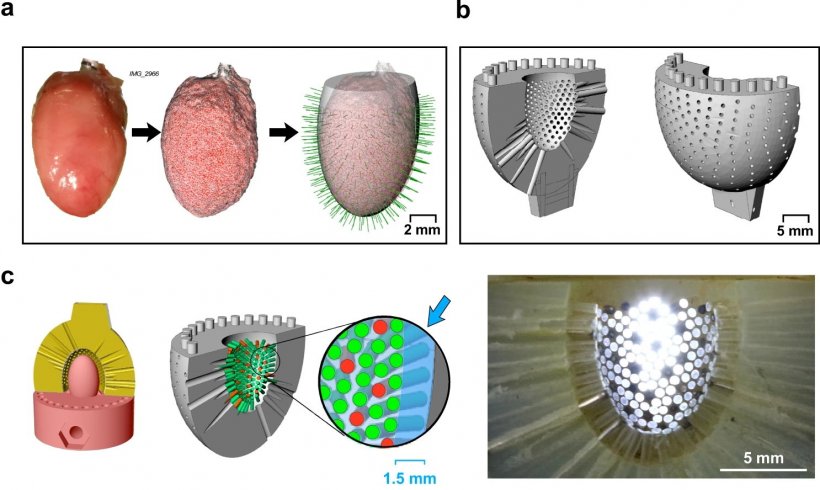
Image source: Rieger et al., Nature Communications (CC BY 4.0)
News • 'POEMS' for cardiology
New method tracks heart activity optical and electrical simultaneously
It is still elusive to what extent interactions between different cell types of the heart influence the normal heart rhythm and possibly trigger life-threatening arrhythmias. A new measurement method developed at the University of Bern combines for the first time optical and electrical recording of cardiac ventricular activation which, in conjunction with optogenetics, will permit finding comprehensive answers to these questions.
The normal function of the heart is based on a pacemaker that generates electrical impulses ('action potentials') which spread rapidly throughout the heart muscle where they trigger the contraction leading to the heartbeat. In the past, it was assumed that the propagation of action potentials was controlled exclusively by cardiac muscle cells. However, recent findings suggest that other cell types of the heart, such as connective tissue cells ('fibroblasts') and macrophages, may additionally affect action potential propagation and, thus, play a significant role in determining cardiac function. These findings were obtained using a new method called optogenetics that uses light to control the electrical behavior of defined cell types like fibroblasts thereby permitting the assessment of their involvement in the cardiac activation process.

© Michael Rieger et. al., from: Rieger et al., Nature Communications (CC BY 4.0)
To enable comprehensive optogenetic studies with hearts, researchers led by Stephan Rohr of the Department of Physiology at the University of Bern developed a new experimental system called 'Panoramic Opto-Electrical Measurement and Stimulation (POEMS)' system. The POEMS system is the first to allow simultaneous optical and electrical measurements and stimulation extending over the entire ventricular surface of mouse hearts. Results obtained with the system are expected to open new perspectives in the study of normal cardiac function and the investigation of mechanisms causing cardiac arrhythmias. The study describing the system was published in the journal Nature Communications.
Cell culture experiments have previously shown that cardiac muscle cells communicate with activated cardiac fibroblasts by means of electrical signals and that this interaction leads to cardiac arrhythmias. However, it is still unknown whether this mechanism is also operational in intact hearts because conventional electrophysiological methods are not suited to investigate this question.

Image courtesy of S. Rohr
The lack of suitable experimental approaches is overcome these days by optogenetics that permits a direct interrogation of the presence and functional consequences of cellular interactions between muscle and non-muscle cells of the heart. Presence of direct electrical communication can be assessed by letting specific cell types like fibroblasts express so-called "optogenetic voltage reporters". On the other hand, the functional consequences of such coupling can be investigated by expressing 'optogenetic voltage actuators' in these cells and by observing the effects of light-activation on whole heart electrophysiology.
Presently, conducting optogenetic experiments is complex and equipment intensive. In addition, it is not possible to combine electrode-based experiments with optical studies, which severely limits the range of possible experiments. "With our POEMS system, all of these disadvantages have been overcome, as the entire surface of the ventricles is covered with a combination of optical and electrical measurement and stimulation sites, which allows free combinations of both modalities," explains Professor Stephan Rohr, lead author of the study. The core of the new POEMS system consists of a cup fitting the size of mouse hearts with its inner surface being lined by 294 optical fibers and 64 electrodes. All optical fibers and electrodes can be individually configured as measurement and stimulation sites thereby permitting a precise tailoring of individual experiments to the specific requirements of the optogenetic reporter and actuator used in a given experiment.
Simultaneous optical and electrical panoramic measurements of cardiac activation using stimulated mouse hearts expressing optogenetic voltage reporters demonstrated that the POEMS system provides, irrespective of the measurement modality, congruent and highly accurate measurements of ventricular action potential propagation with differences between optically and electrically determined activation times less than a millisecond. Going beyond, the POEMS system was designed with the goal to enable straightforward and efficient experimentation. "With our 'drop&go' approach, experiments can be started immediately after the isolated mouse is placed in the measurement container," says co-author of the study Michael Rieger, who developed the system together with other members of the Department of Physiology. The gentle treatment of the hearts increasing the success rate of experiments as well as the increased information content provided by the POEMS system is also relevant with regards to the 3R principles (replace, reduce, refine) because the number of animal experiments needed to answer a given question can be substantially reduced. "With the POEMS system in place, we are presently investigating the burning question of whether cardiac arrhythmias can also be caused by non-muscle cells such as activated connective tissue cells," says Stephan Rohr. If this should be the case, it would open up new avenues for the treatment of cardiac arrhythmias as cell types different from muscle cells may become targets for anti-arrhythmic therapies.
Source: University of Bern
06.10.2021











